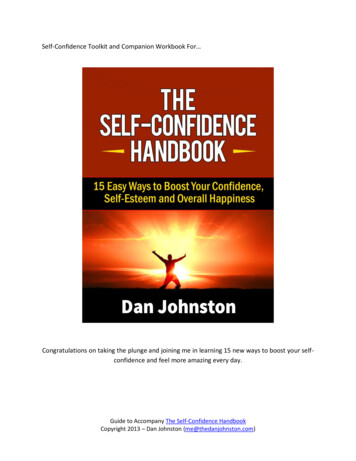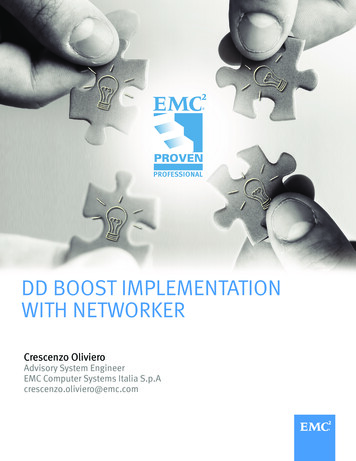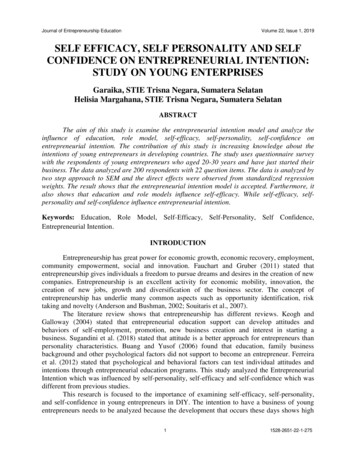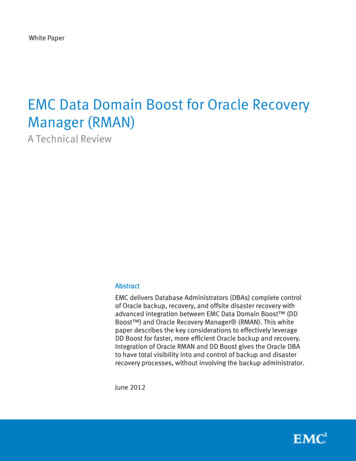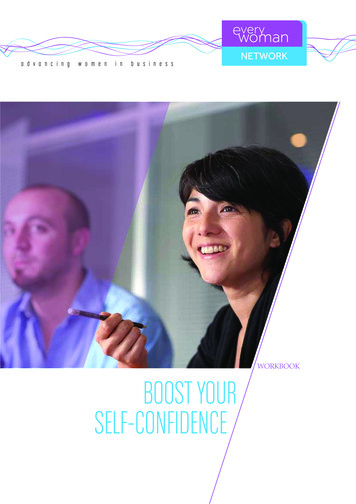
Transcription
a d v a n c i n gw o m e ni nb u s i n e s sWORKBOOKBOOST YOURSELF-CONFIDENCE
CONTENTS3About this workbook4Introduction5Section 1. Your confidence6How assertive are you?8How high or low is your self-esteem?11Know what you do well14How do you want to be perceived?Your value system1517What do other people think?19Identifying areas of low confidenceSection 2. Building your confidenceGet mentoredChallenge your thinkingAffirmationsSetting goals212223262832Section 3. Communicating your confidence33Manage your thinking34Manage your attitude and behaviour36Non-verbal communication37Visual image39Listening skills41Questioning skillsSection 4. Keeping up the momentumTurn theory into realityStrategiesYour confidence planFive tips HYHU\ZRPDQ H[SHUW IXUWKHU UHDGLQJ434445464748www.everywoman.com2
ABOUT THIS WORKBOOKESTABLISHED IN 1999, everywomanworks to advance all women in business.Through our work with individualsand organisations, we know that beingconfident and assertive is a key elementto paving a successful path in business.Fortunately, your levels of confidencecan be built up over time, just like allother personal development areas. Inthis workbook, we will give you not onlythe theory behind confidence building,but also some practical exercises that willhelp you develop your confidence.In this workbook, we will help you tounderstand where you are starting from,the role that self-esteem plays in buildingconfidence and tips on what to put intopractice to help you become a confidentand assertive businesswoman.We will help you identify the personalstrengths you already possess that youcan tap into. Then, when reading througheach chapter, make sure you spend timecarrying out the actions and tasks thataccompany each section – these are theparts that will really help you develop.Over the past decade, we have metwith thousands of businesswomen,and the subject of confidence comes upfrequently. We are in no doubt that thereare core differences between men andwomen in this area, especially when itcomes to communicating with others anddealing with conflict.Our quarterly online seminars willsupport the key learning points in thisworkbook and give an opportunity to askour experts any questions you may have.If you are unable to join us for any of thelive events, you can listen to the seminarsshortly afterwards when they are postedas videos to the everywoman site.This subject is therefore of specialimportance to women and it has madethis particular workbook a big one. Butdon’t worry: we will guide you throughit while boosting your confidence levels,regardless of your starting point.Good luck! We look forward to seeingyou on the everywomanNetwork andhearing how you have benefited from thisconfidence-building workbook.The everywoman teamwww.everywoman.com3
INTRODUCTIONCONFIDENCE IS NOT somethingwe are born with. It is shaped byexperiences in childhood, earlyadolescence and adulthood.Confidence is more than just a state ofmind or a skill that can be enhancedover time. It is a barometer of how youperceive yourself. The good news is thatyou can build up this belief in yourselfover time.Confidence is a constantly evolvingstate of being. We can feel amazinglyconfident carrying out some tasks andhave a crippling fear of others. Think ofa neurosurgeon: no one can doubt herintelligence, dedication and skill, yet askher to present to an audience of her peersand you may see the colour drain fromher face.The act of building your confidence canseem daunting. However, the freedomyou will feel when you have deep-rootedself-assurance will be exhilarating. Havingconfidence doesn’t mean you will neverfeel fearful, but it allows you to workthrough your fears and enjoy the processof moving out of your comfort zone. This,in turn, builds even more confidence.No one can build your confidence foryou, so if you want to change, you mustbe willing to give it a go. There may besections of this workbook that you feelyou can act on immediately. There will beothers that will challenge you and forceyou to think more deeply.The most important foundation forbuilding confidence is to remember thatyou don’t need to, and must not aspireto, change overnight. It takes time tobecome confident, both internally andto others. It is not about being outsideof your comfort zone and entering the‘panic zone’ as shown below. It is aboutworking hard to make that comfortzone bigger.PANIC ZONELEARNING ZONECOMFORT ZONEwww.everywoman.com4
SECTION 1.YOURCONFIDENCEBefore we boost your confidence,let’s take a look at where you currently standwww.everywoman.com5
How assertive are you?ASSERTIVE PEOPLE COME ACROSS as confident and in control. They express their views and opinions withoutappearing aggressive; they value the views and opinions of others and can influence outcomes.Assertiveness v self-confidenceAssertiveness cannot existwithout there being interactionwith another personSelf-confidence can existin isolationThat said, assertiveness and self-confidence are inextricably linked. Confidence givesyou the inner strength to take control of a situation. Assertiveness is how we externallydemonstrate self-confidence.Complete the self-diagnostic below to analyse how assertive you are at work.EXERCISEHow assertive are you at work?1) HOW OFTEN DO YOU FEEL THAT THINGS ARE ‘DUMPED’ ON YOU?a) Quite a lot of the time, but that’s how it isb) Not very often. I’m generally in control because I manage expectationsc) No one would dare2) WHAT DO YOU DO IF YOU’RE STRUGGLING TO BE HEARD?a) Nothing. The other person generally knows more than meb) I indicate when I’m going to speak by maintaining eye contactand using my body languagec) I speak louder and more forcefully. That way, they have to listen3) HOW DO YOU HANDLE CHALLENGING CONVERSATIONS?a) I tend to give in; I don’t like conflictb) I listen to the other person, take stock of the situation and work towards a win/win solutionc) I’ll go to any lengths to get my own way1. YOUR CONFIDENCE2. BUILDING YOUR CONFIDENCE3. COMMUNICATING YOUR CONFIDENCE4. KEEPING UP THE MOMENTUMwww.everywoman.com6
How assertive are you?EXERCISE continued4) HOW DO YOU FEEL YOU ARE VIEWED IN THE BUSINESS?SCORINGa) I don’t feel I am valued; I’m always overruled and ignoredb) I feel respected and feel that most people would sayI do a good jobc) As long as I’m good at what I do, I don’t really carewhat they think. What does it matter?a 1, b 2 and c 35–8. This score indicates that you may be at the passive endof the assertiveness scale. Potentially, you are being taken forgranted – or at least perceive that you are. It might be a goodidea to seek out the advice of a trusted colleague or mentor whomay be able to help you be more assertive.5) HOW DO YOU FEEL ABOUT PRESENTING TOYOUR PEERS?a) I worry because I doubt my abilityb) It’s exciting to share the great things I’minvolved inc) It’s important that my peers understandhow good I am9–12. This score indicates that you are probably assertive. Remember,confidence and assertiveness are like muscles, so exercise them.13–15. This score indicates that you may come across as aggressive, which cancause unnecessary conflict and tension at work. Being assertive rather thanaggressive is a more balanced way to operate and will lead to greater results.PASSIVEA passive person will avoid expressing theiropinions, generally believing that they are notworth taking care of. Passive people will usuallynot assert themselves or openly verbalisetheir feelings or needs, allowing others to rideroughshod over them. This can amount to apassive person often feeling anxious, depressedand sometimes resentful.ASSERTIVEAn assertive person is very clear about theiropinions, needs and feelings and is able toexpress these freely without fear of reprisal.They will also generally have high regard forothers, actively listening to other viewpoints andcommunicating in a calm and respectful manner.AGGRESSIVEAn aggressive individual is clear abouttheir needs and opinions and will step overeveryone to get it. They can be verballyand sometimes physically abusive, and thiscan be displayed in a variety of ways, fromnot respecting someone’s personal spaceto verbally attacking or ridiculing them.Interestingly, this ego state is generally bornout of a feeling of powerlessness and a lackof self-esteem.PASSIVE-AGGRESSIVEPassive-aggressive individuals appear passiveon the surface but are affected by dramaticemotions underneath the surface. Rather thanconfront an issue, they will smile sweetly andcarry out acts of sabotage on the focus of theirresentment. This, again, is born from a feelingof powerlessness and a lack of self-esteem.With the exception of assertiveness, the otherthree states, although wildly different indisplayed behaviour, stem from a lack ofpower or a feeling of unworthiness and a needto be addressed.Non-assertiveness may be seen as the useof inefficient communication skills, whereasassertiveness is considered a balanced response,being neither passive nor aggressive.Being assertive involves taking into considerationnot only your own rights, wishes, wants, needsand desires, but also those of the other person.Assertiveness means encouraging others to beopen and honest about their views, wishes andfeelings so that both parties act appropriately.1. YOUR CONFIDENCE2. BUILDING YOUR CONFIDENCE3. COMMUNICATING YOUR CONFIDENCE4. KEEPING UP THE MOMENTUMwww.everywoman.com7
How high or low is your self-esteem?SELF-ESTEEM IS THE FOUNDATION on which your confidence is built. It is your overallevaluation of your worth or value. If you don’t hold yourself in high regard, you won’tbehave confidently around others.Before you can develop high self-esteem, we need to understand wherelow self-esteem comes from.What are some reasons for low self-esteem? Negative thinking Self-sabotage Low emotional intelligence Not upholding your value system“Nobody can makeyou feel inferiorwithout your consent”ELEANOR ROOSEVELT1. YOUR CONFIDENCE2. BUILDING YOUR CONFIDENCE3. COMMUNICATING YOUR CONFIDENCE4. KEEPING UP THE MOMENTUMwww.everywoman.com8
How high or low is your self-esteem?EXERCISEThe Rosenberg self-esteem scaleThe Rosenberg self-esteem scale was developed by Dr Morris Rosenberg and is used widely in social science research.Because the concept of self-esteem is one that most people are familiar with, this test will probably not tell youanything you do not already know. You should have a pretty good grasp of your results just by asking yourself thequestion, “Do I have low self-esteem?” Where this scale is helpful is in giving you a numerical indication of yourself-esteem health. The clearer you are about your self-esteem, the better you can learn to take care of yourself.Don’t take this as a precise measure, but use it as a guide. Learn what you need to work on and think more deeplyabout why you feel the way you do.Respond to the items quickly, without over-thinking; tick your first onglydisagree1. I feel I am a person of worth, at least onan equal plane with others2. I feel that I have a number ofgood qualities3. All in all, I am inclined to feel thatI am a failure4. I am able to do things as well as mostother people5. I feel I do not have much to be proud of6. I take a positive attitude towards myself7. On the whole, I am satisfied with myself8. I wish I could have more respectfor myself9. I certainly feel useless at times10. At times I think I am no good at allTURN OVER TO SEE WHAT YOUR SCORE ME ANS1. YOUR CONFIDENCE2. BUILDING YOUR CONFIDENCE3. COMMUNICATING YOUR CONFIDENCE4. KEEPING UP THE MOMENTUMwww.everywoman.com9
How high or low is your self-esteem?SCORINGFor items 1, 2, 4, 6 and 7:Strongly agree 3Agree 2Disagree 1Strongly disagree 0For items 3, 5, 8, 9 and 10:Agree 1Disagree 2Strongly disagree 3Your score:The scale ranges from 0-30. Scores between 15 and 25 are within normal range;scores below 15 suggest low self-esteem.How can you use this number? It is important to remember that our frame of mindwhen we take a questionnaire like this will often slightly affect the results. That said, it willshow where you sit compared with others – and reassure you that most people have averageself-esteem. It is perfectly common to not feel 100% positive, useful and effective at all times.If your score is low, don’t worry. The next steps in this workbook will help you becomemore confident in your day-to-day environment. If your score was medium to high, thereare still many areas that you can focus on, such as goal setting, giving and receivingfeedback and building on any areas you will identify where you are less confident.EXERCISEWhat does self-esteem mean to you?Think about a time when you felt your self-esteem was high. If you truly can’tthink of a time, think about someone else with high self-esteem and answerthe questions from his or her point of view. Where were you? What were you doing? In what way did you behave differently? In what way did you think differently?Compare this with a situation where you feltyour self-esteem was low. Where were you? What were you doing? How were you behaving? Were there any particular patterns or themesto your thinking?ActionNow that you understand what selfesteem is, it will be easier to work ondeveloping it. The next time you feelyour self-esteem has been knockeddown, or it needs a boost, look at the areashighlighted in this section and reflect onwhat has happened, and then create somesmall steps to help yourself. If you havea mentor (see section 2), you could workthrough this area with them.1. YOUR CONFIDENCE2. BUILDING YOUR CONFIDENCE3. COMMUNICATING YOUR CONFIDENCE4. KEEPING UP THE MOMENTUMwww.everywoman.com10
Know what you do wellOFTEN, WE ARE TOO FOCUSED on what we have not been able to accomplish or do perfectly. We forgetto acknowledge our successes, let alone celebrate them. Being confident means knowing what you dowell and continuing to do it more. It means identifying what is already working and focusing on yourcore strengths.What have you done in the past week?EXERCISEIn which roles have you had success?Think about all the different roles you might have in life:MOTHERSISTERDAUGHTERCHEFCLE ANERCOACHCOUNSELLORCHAUFFEURCOUSINBOSSCOLLE SISTANTMANAGERAUNTGODMOTHERWrite down at least three things you have successfully accomplished in the pastweek within one or more of the roles above.1.2.3.1. YOUR CONFIDENCE2. BUILDING YOUR CONFIDENCE3. COMMUNICATING YOUR CONFIDENCE4. KEEPING UP THE MOMENTUMwww.everywoman.com11
Know what you do wellTake time to acknowledge the successes you have had in the many roles you play in life. We oftenfail to recognise the value we individually bring to our own and others’ lives.Now try thinking even more broadly. What more far-reaching successes have you had in your life?It might help to categorise them using the areas below. Don’t worry about how big or small theaccomplishment is; it is vital to understand that every achievement is tracurricularSpiritualAny other areas?1. YOUR CONFIDENCE2. BUILDING YOUR CONFIDENCE3. COMMUNICATING YOUR CONFIDENCE4. KEEPING UP THE MOMENTUMwww.everywoman.com12
Know what you do wellNow, take a few minutes to look through each area to appreciate what you have achieved so far.It may be that you see areas where you wish you could achieve more. Perhaps you have been sittingin your comfort zone too long and have lost sight of how to challenge yourself. Looking back tellsus what we have achieved; now you need to look forward to see what else is on the horizon.Capture the positive feelings that materialise when you recall a success and think about howto relive those feelings. Being confident is about using positives from the past to help you beeven more successful in the future.“Being confidentis giving yourselfa pat on the back whenno one else does”ActionBefore moving on to the next exercise,think about how the previous exercisehelped you. Find a way to take a fewminutes every week to think about whatyou have achieved and reflect on whatyou can learn from those successes.1. YOUR CONFIDENCE2. BUILDING YOUR CONFIDENCE3. COMMUNICATING YOUR CONFIDENCE4. KEEPING UP THE MOMENTUMwww.everywoman.com13
How do you want to be perceived?PEOPLE GRAVITATE TO THOSE with self-confidence, because when you have it, your ability to influence,inspire and guide flourishes. The best way to start building confidence is to truly understand yourstarting point. Everyone has strengths, but it is sometimes difficult to discover them.EXERCISEWho are your role models?Think about those you would classify as successful. It can be people you work with,socialise with or even someone famous you ‘know of’ but do not really know. Listsome of the qualities that you think make them successful. Does confidence come into play? It might even be confidence disguised asstrengths, such as being self-aware, finding it easy to speak to people or havinghigh self-regard or an ability to set and meet goals.Now, list some things you already have in common with them. How you want to be perceived will to some degree beshaped by your values. Let’s look at those next.1. YOUR CONFIDENCE2. BUILDING YOUR CONFIDENCE3. COMMUNICATING YOUR CONFIDENCE4. KEEPING UP THE MOMENTUMwww.everywoman.com14
Your value systemWE HAVE ALL BEEN IN A SITUATION where we have to question whether what we are undertaking is what we trulyfeel is the right thing to do. Being asked to work in a way that contradicts our own value system can have adamaging effect. If we lack assertiveness to push back or stand up for what we believe in, it can wear downour confidence. Our value system is our internal compass, pointing us in the right direction.EXERCISEWhat are your core values?Think back to when we asked you to consider examples in which you had success. Look again at each area and try toestablish what you perceive as your values in those areas. See if there are any warning signs – areas in which your valuesaren’t matching your success. For example, you may have made new friends at work who you now go out with often, butin turn have opted out of some longstanding engagements related to charity work you are involved in. Is this really whatyou want to happen?List your core values for the acurricularSpiritualAny other areas?1. YOUR CONFIDENCE2. BUILDING YOUR CONFIDENCE3. COMMUNICATING YOUR CONFIDENCE4. KEEPING UP THE MOMENTUMwww.everywoman.com15
Your value systemWhat are the three values you want to work harder to align yourself with?How will you do it?ActionValue1.2.3.“It’s not whoyou are that holdsyou back, it’s whoyou think you’re not”ATTRIBUTED TO HANOCHMCCARTHY1. YOUR CONFIDENCE2. BUILDING YOUR CONFIDENCE3. COMMUNICATING YOUR CONFIDENCE4. KEEPING UP THE MOMENTUMwww.everywoman.com16
What do other people think?FOR SOME PEOPLE, THE AREAS in which they need to build their confidence are obvious. For others, it is hard todetermine the starting point, or perhaps to find specific areas that they could build on. Try asking those youtrust what they think are the areas in which you lack confidence or that need development.Firstly, and most importantly, make sure you are seeking feedback in order to develop yourconfidence, rather than just looking for approval or aiming to be congratulated. When seekingfeedback, make it easy for the person to give you useful and relevant feedback by being specific.Asking “How was my presentation?” will not normally get more than a “Great, well done”.Keep the following in mind when you are seeking feedback:Know what you wantWhat exactly do you need feedback on and how will you use it?Ask specific questionsDon’t be vague: asking a specific question will get you a focused answer.Seek from the right sourcesWho will be most honest? Seek upward, peer and lower-level feedback.What questions can you ask to get real and useful feedback?Here are some examples: “What two things do you think I could focus on so that I would be perceived as more confident?” “In that presentation, did I make eye contact with the client?” “What else could I have done to engage the client more?” “ In your opinion, what are two or three of my strengths? Could you please provide an example of when you have observed them?”“What could I do differently to be more effective?”“What should be the priorities for my personal development?”“What specifically am I doing well? What could be done even better?”1. YOUR CONFIDENCE2. BUILDING YOUR CONFIDENCE3. COMMUNICATING YOUR CONFIDENCE4. KEEPING UP THE MOMENTUMwww.everywoman.com17
What do other people think?What about receiving the feedback?Receiving feedback is incredibly difficult at the best of times. Even when we know something iscompletely true, it is hard to hear it come out of someone else’s mouth. You know your desk is messy– it is obvious to everyone – but being told that by someone else somehow makes us defensive.However, if you want to develop your confidence, learning how to receive and use feedback is a vitalskill. It takes time and practice and will get easier to do the more you do it. Showing you can handleboth developmental and positive feedback is a sure sign that you are a confident person.Try to remember the tips below next time you have a feedback discussion.Listen Accept the impact of the feedback (you don’t have to agree with it, but at this point bite your tongue!) Evaluate feedback before responding Ask for specific examplesDon’t interrupt Focus on actions and next steps Don’t dwell on it Don’t justify your positionEXERCISEGetting great feedbackThink about a few questions you could ask someone who is honest and trustworthy.1.2.3.Who are you going to ask? Remember, people will be flattered that you have asked for their opinion.1.2.3.Make a commitment to get the feedback in the next week.1. YOUR CONFIDENCE2. BUILDING YOUR CONFIDENCE3. COMMUNICATING YOUR CONFIDENCE4. KEEPING UP THE MOMENTUMwww.everywoman.com18
Identifying areas of low confidenceTHIS SELF-ANALYSIS TOOL WILL HELP you to identify tasks, areas or situations where you do not feel confident.By analysing the reasons behind your lack of confidence in these areas, you can begin to appreciate how internaland external factors influence how you feel in certain situations and when carrying out particular tasks.EXERCISESet confidence goalsMake a list of the areas in which you don’t yet feel confident. Then, imagining that you arealready supremely confident, decide on two goals you’d like to achieve in the coming month.Here are two example lists:Tasks, areas or situations where I do notfeel confidentCommon factors: why I feel under-confidentin this scenarioe.g. Standing up and presenting at monthlyupdate meetingse.g. Knowledge: because I worry that I won’t beable to answer all the questions I am askedNow, focusing on the reasons you feel under-confidentcarrying out the tasks in the left-hand column, make alist of the common factors belowNow that you have identified your common reasonsfor under-confidence, write a list of the strategiesyou will use to make you feel more confident inthese situationse.g. Lack of knowledge, lack of experience, lackof feedbacke.g. Research the subject matter in advance andtry to anticipate questions. Make time to practiceat least a day beforeBy identifying the common factors that make you feel under-confident in a situation(such as lack of knowledge), next time you are faced with a task or scenario where youdo not feel confident, you can use the strategies above to help you deal with it.Now, fill out the worksheets on the next page with your own scenarios.1. YOUR CONFIDENCE2. BUILDING YOUR CONFIDENCE3. COMMUNICATING YOUR CONFIDENCE4. KEEPING UP THE MOMENTUMwww.everywoman.com19
Identifying areas of low confidenceEXERCISEAnalysing your under-confidenceTasks, areas or situations where I do notfeel confidentWhy do you feel under-confident in thesescenarios? (If you find this difficult tounderstand now, wait until you have workedthrough this workbook)Now, focusing on the reasons you feel underconfident carrying out the tasks above, makea list of the common factors belowHaving identified your common reasons for underconfidence, write a list of strategies that willmake you more confident in these situations(DON’T fill this section in now. This will be part ofyour action planning at the end of this workbook)1. YOUR CONFIDENCE2. BUILDING YOUR CONFIDENCE3. COMMUNICATING YOUR CONFIDENCE4. KEEPING UP THE MOMENTUMwww.everywoman.com20
SECTION 2.BUILDING YOURCONFIDENCEHaving laid the groundwork,let’s look at specifictechniques forconfidence-boostingwww.everywoman.com21
Get mentoredMENTORING IS A CONTINUAL process of enabling people to reach ever-higher levels of performance andachievement. If you don’t already have a mentor, now is the time to get one.Perhaps it’s someone who you asked for feedback in the previous exercise, or you may have foundanother person who was particularly easy to relate to and who offered valuable advice.Your mentor will be an impartial sounding board and will also provide support should you encounterany challenges. He or she can be from within your organisation or from outside.When choosing one, remember that a mentor is:SupportiveEncourages you to take risks that are reasonable and that will result in your professional and personal development.NurturingCreates a ‘risk free’ environment where you can share the issues that are most critical to you, knowing that it willbe used to aid your development.ProtectiveMakes sure that you have all the information needed to make informed decisions and provides you with the criticalknowledge and understanding of situations so that you get the ‘complete picture’ before taking any action.A good mentor also: Provides the necessary critique that allows you to know what you are doing well and what areas can be further developed. This is especially important for boosting your confidence levelsCan set limits with you and understands that his or her job is not to create a clone, but to shareknowledge and informationYour mentor will devote the necessary time to the relationship, will be available basedon what is agreed at the beginning of the relationship and will be credible – someoneyou can trust.Ideally, as a mentee, you will: Listen and take advice Be open to other viewpoints Be courageous and share viewpoints Take responsibility for learning Be motivated to stay engaged and work to achieve results Commit to and honour the time your mentor spends with you Commit to undertake an agreed course of action during the process2. BUILDING YOUR CONFIDENCE1. YOUR CONFIDENCE3. COMMUNICATING YOUR CONFIDENCE4. KEEPING UP THE MOMENTUMwww.everywoman.com22
Challenge your thinkingBanish negative thinkingIt is not rocket science, but we may not realise that people react to us because of our behaviour. Andour behaviour is a result of what we believe. If we believe we can’t do something, we won’t. Sayingto yourself that you will never remember your whole presentation means you probably won’t. Sayingto yourself that nobody listens to you in meetings probably means you won’t speak up for yourself.We have all heard it before: “You are your own worst enemy.”This is what we call self-sabotage –when we stop ourselves from achieving what we want, whether it’s a small goal or a huge dream.Useful thinking is the ability to modify our thinking to allow us to react more effectively andappropriately to events in our lives.Positive thinking means we use inner dialogue to move us purposefully towards solutionsto our problems.Here are some examples of the range from negative to useful thinking.Negative thinkingLess-effective thinkingPositive thinkingI’m so nervous I’ve blown it!Don’t get anxious! You’ll blow it!I am usually calm and confident –I will cope with it.I was a total failure. Everyone willthink I’m an idiot.I wasn’t a total failure.Maybe next time.Most of it was OK. I’ll know whatto do next time.I didn’t get anything I wanted.I’ll never do any better.I didn’t get all I wanted.I should have done it better.I didn’t get everything I wanted,but I did it and that’s reallypositive. I’m making progress.2. BUILDING YOUR CONFIDENCE1. YOUR CONFIDENCE3. COMMUNICATING YOUR CONFIDENCE4. KEEPING UP THE MOMENTUMwww.everywoman.com23
Challenge your thinkingEXERCISEMonitor your negative thinking1. For a day or two, keep track of all the negative thoughts you have. This will train your mind torecognise when you are thinking negatively2. Think about some positive thoughts that you can call on when you catch yourself thinking negatively3. For a week, pick an hour every day that you will refuse to have negative thoughts. When they creepinto your head, push them away with your positive thoughts4. Once you have managed to do an hour a day for at least three days running, move on to half a day.Pick morning or afternoon and stick to it, no matter what comes up5. By now, it should be getting a bit easier and you are hopefully noticing fewer negative thoughtscreeping in. When they do, you should be able to push them out faster. Now, try for a full dayWhat did you notice? What do you still need to work on? What is still causing you to thinknegatively? Were there any patterns in your thinking? If they are about a specific area suchas your appearance or your leadership style, you have a ready-made goal to focus on.If the negative thoughts focus on a wide range of areas, you may need to work on your overallself-esteem.By picking a timeframe, you are helping to keep the issue in your conscious mind. When we let itslide to our subconscious, it is easy to slip back into old habits. So keep going until you find thatyou are satisfied at the end of the day with how your inner dialogue is focused.How can you sustain this positiv
1. YOUR CONFIDENCE 8 How high or low is your self-esteem? SELF-ESTEEM IS THE FOUNDATION on which your confidence is built. I t is your overall evaluation of your worth or value. f you don’t hold yourself in high regard, you won’t I behave confidently around others. Before you can develop high


